
2016 Goldman Sachs Financial Services Conference William H. Rogers Jr., Chairman and Chief Executive Officer, SunTrust Banks, Inc. December 6, 2016

2 The following should be read in conjunction with the financial statements, notes and other information contained in the Company’s 2015 Annual Report on Form 10-K, Quarterly Reports on Form 10-Q, and Current Reports on Form 8-K. This presentation includes non-GAAP financial measures to describe SunTrust’s performance. We reconcile those measures to GAAP measures within the presentation or in the appendix. In this presentation, we present net interest income and net interest margin on a fully taxable-equivalent (“FTE”) basis, and ratios on an annualized basis. The FTE basis adjusts for the tax-favored status of income from certain loans and investments. We believe this measure to be the preferred industry measurement of net interest income and provides relevant comparison between taxable and non-taxable amounts. This presentation contains forward-looking statements. Statements regarding future levels of the efficiency ratio, future number of branches, and capital return are forward-looking statements. Also, any statement that does not describe historical or current facts is a forward-looking statement. These statements often include the words “believes,” “expects,” “anticipates,” “estimates,” “intends,” “plans,” “targets,”, “strategies”, “initiatives,” “opportunity,” “potentially,” “probably,” “projects,” “outlook” or similar expressions or future conditional verbs such as “may,” “will,” “should,” “would,” and “could"; such statements are based upon the current beliefs and expectations of management and on information currently available to management. Such statements speak as of the date hereof, and we do not assume any obligation to update the statements made herein or to update the reasons why actual results could differ from those contained in such statements in light of new information or future events. Forward-looking statements are subject to significant risks and uncertainties. Investors are cautioned against placing undue reliance on such statements. Actual results may differ materially from those set forth in the forward-looking statements. Factors that could cause actual results to differ materially from those described in the forward-looking statements can be found in Part I, Item 1A., “Risk Factors,” in our Annual Report on Form 10-K for the year ended December 31, 2015 and in other periodic reports that we file with the SEC. Those factors include: current and future legislation and regulation could require us to change our business practices, reduce revenue, impose additional costs, or otherwise adversely affect business operations or competitiveness; we are subject to increased capital adequacy and liquidity requirements and our failure to meet these would adversely affect our financial condition; the fiscal and monetary policies of the federal government and its agencies could have a material adverse effect on our earnings; our financial results have been, and may continue to be, materially affected by general economic conditions, and a deterioration of economic conditions or of the financial markets may materially adversely affect our lending and other businesses and our financial results and condition; changes in market interest rates or capital markets could adversely affect our revenue and expenses, the value of assets and obligations, and the availability and cost of capital and liquidity; our earnings may be affected by volatility in mortgage production and servicing revenues, and by changes in carrying values of our MSRs and mortgages held for sale due to changes in interest rates; disruptions in our ability to access global capital markets may adversely affect our capital resources and liquidity; we are subject to credit risk; we may have more credit risk and higher credit losses to the extent that our loans are concentrated by loan type, industry segment, borrower type, or location of the borrower or collateral; we rely on the mortgage secondary market and GSEs for some of our liquidity; loss of customer deposits could increase our funding costs; we are subject to litigation, and our expenses related to this litigation may adversely affect our results; we may incur fines, penalties and other negative consequences from regulatory violations, possibly even inadvertent or unintentional violations; we are subject to certain risks related to originating and selling mortgages, and may be required to repurchase mortgage loans or indemnify mortgage loan purchasers as a result of breaches of representations and warranties, or borrower fraud, and this could harm our liquidity, results of operations, and financial condition; we face certain risks as a servicer of loans; we are subject to risks related to delays in the foreclosure process; clients could pursue alternatives to bank deposits, causing us to lose a relatively inexpensive source of funding; consumers and small businesses may decide not to use banks to complete their financial transactions, which could affect net income; we have businesses other than banking which subject us to a variety of risks; negative public opinion could damage our reputation and adversely impact business and revenues; we rely on other companies to provide key components of our business infrastructure; competition in the financial services industry is intense and we could lose business or suffer margin declines as a result; maintaining or increasing market share depends on market acceptance and regulatory approval of new products and services; our ability to receive dividends from our subsidiaries or other investments could affect our liquidity and ability to pay dividends; any reduction in our credit rating could increase the cost of our funding from the capital markets; we have in the past and may in the future pursue acquisitions, which could affect costs and from which we may not be able to realize anticipated benefits; we depend on the expertise of key personnel, and if these individuals leave or change their roles without effective replacements, operations may suffer; we may not be able to hire or retain additional qualified personnel and recruiting and compensation costs may increase as a result of turnover, both of which may increase costs and reduce profitability and may adversely impact our ability to implement our business strategies; our framework for managing risks may not be effective in mitigating risk and loss to us; our controls and procedures may not prevent or detect all errors or acts of fraud; we are at risk of increased losses from fraud; a failure in or breach of our operational or security systems or infrastructure, or those of our third party vendors and other service providers, including as a result of cyber-attacks, could disrupt our businesses, result in the disclosure or misuse of confidential or proprietary information, damage our reputation, increase our costs and cause losses; the soundness of other financial institutions could adversely affect us; we depend on the accuracy and completeness of information about clients and counterparties; our accounting policies and processes are critical to how we report our financial condition and results of operation, and they require management to make estimates about matters that are uncertain; depressed market values for our stock and adverse economic conditions sustained over a period of time may require us to write down some portion of our goodwill; our financial instruments measured at fair value expose us to certain market risks; our stock price can be volatile; we might not pay dividends on our stock; and certain banking laws and certain provisions of our articles of incorporation may have an anti-takeover effect. Important Cautionary Statement

3 Investment Thesis Why invest in SunTrust? Investing in Growth Opportunities Strong & Diverse Franchise Improving Returns & Efficiency Strong Capital Position Supports Growth

4 SunTrust Overview SunTrust is a leading financial institution focused on meeting clients’ needs and improving their financial well-being. Our Company is differentiated by: 1 Size Large enough to compete with the largest banks while still being able to serve our clients as “One Team” 2 Diverse Business Strong regional bank with key national businesses and full product capabilities 3 Attractive Footprint Leading market shares in growth markets in Southeast & Mid-Atlantic; supplemented by growing presence nationally 4 Culture A “Client First” culture centered on our purpose of Lighting the Way to Financial Well-Being See appendix slide 24 for footnotes Key Statistics (Rank)1,2 $25.6B Market Cap ~5.6MM Clients $205B (11th) Assets $158B (10th) Deposits $142B (10th) Loans Deposit Market Share in Respective Top 10 MSAs4 23,854 Teammates3 14% 6% SunTrust Peer Median #2 of 11 Investing in Growth Opportunities Strong & Diverse Franchise Improving Returns & Efficiency Strong Capital Position
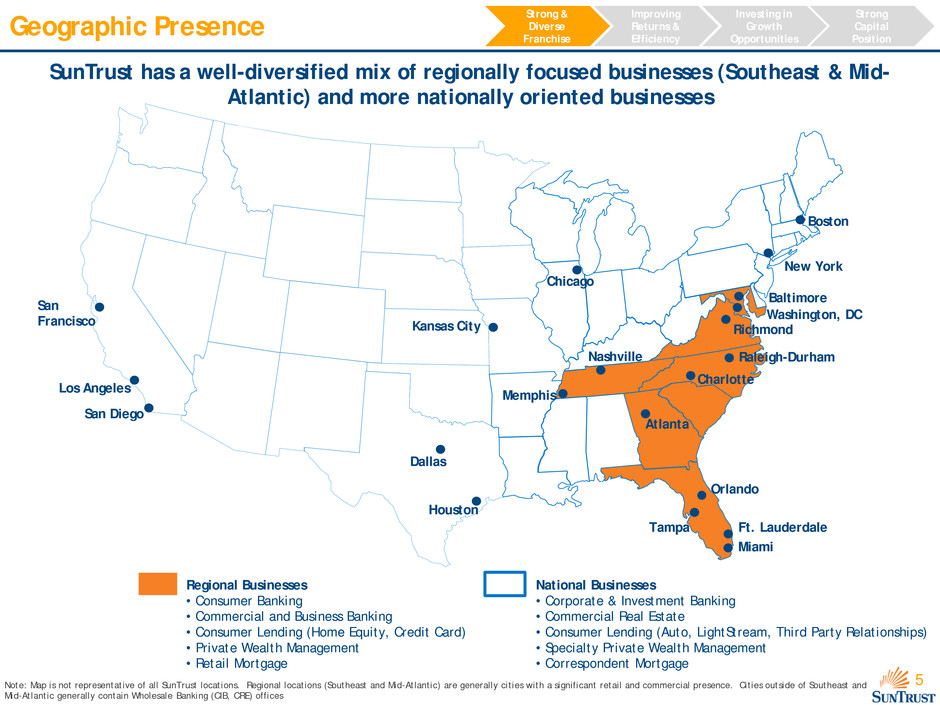
5 Geographic Presence Regional Businesses • Consumer Banking • Commercial and Business Banking • Consumer Lending (Home Equity, Credit Card) • Private Wealth Management • Retail Mortgage National Businesses • Corporate & Investment Banking • Commercial Real Estate • Consumer Lending (Auto, LightStream, Third Party Relationships) • Specialty Private Wealth Management • Correspondent Mortgage SunTrust has a well-diversified mix of regionally focused businesses (Southeast & Mid- Atlantic) and more nationally oriented businesses Investing in Growth Opportunities Strong & Diverse Franchise Improving Returns & Efficiency Strong Capital Position Los Angeles San Francisco Dallas Houston Atlanta Orlando Miami Tampa Chicago Nashville Memphis Charlotte Richmond Baltimore New York Boston Ft. Lauderdale Raleigh-Durham Washington, DC San Diego Note: Map is not representative of all SunTrust locations. Regional locations (Southeast and Mid-Atlantic) are generally cities with a significant retail and commercial presence. Cities outside of Southeast and Mid-Atlantic generally contain Wholesale Banking (CIB, CRE) offices Kansas City

6 Corporate & Investment Banking 20% Commercial & Business Banking 14% Mortgage 12% Consumer Banking 31% Private Wealth Management 11% Consumer Lending 8% Diverse Business Mix1 Investing in Growth Opportunities Strong & Diverse Franchise Improving Returns & Efficiency Strong Capital Position Consumer Banking & PWM 50% • Consumer Banking • Private Wealth Management • Home Equity • Credit Card • Auto Lending • LightStream • Third-Party Partnerships • Specialty Private Wealth Management Wholesale Banking 36% • Commercial & Business Banking • Regional CRE • Affordable Housing • Corporate & Investment Banking (SunTrust Robinson Humphrey) • National CRE (REIT, Institutional, Pillar Financial2) Mortgage 12% • Retail • Correspondent • Consumer Direct % of STI Revenue Regional Businesses (Southeast & Mid-Atlantic) National Businesses 1. Based on revenue (FTE) over the 12 months ending September 30, 2016. Excludes Corporate Other. Totals may not foot due to rounding 2. On October 20, 2016, SunTrust Banks, Inc. announced that it had signed a definitive agreement to acquire substantially all of the assets of the operating subsidiaries of Pillar Financial, LLC. Please see http://investors.suntrust.com/news/news-details/2016/SunTrust-Bank-to-Acquire-Assets-of-Pillar-Financial-LLC/default.aspx for more information. Transaction is expected to close in late 2016 or early 2017
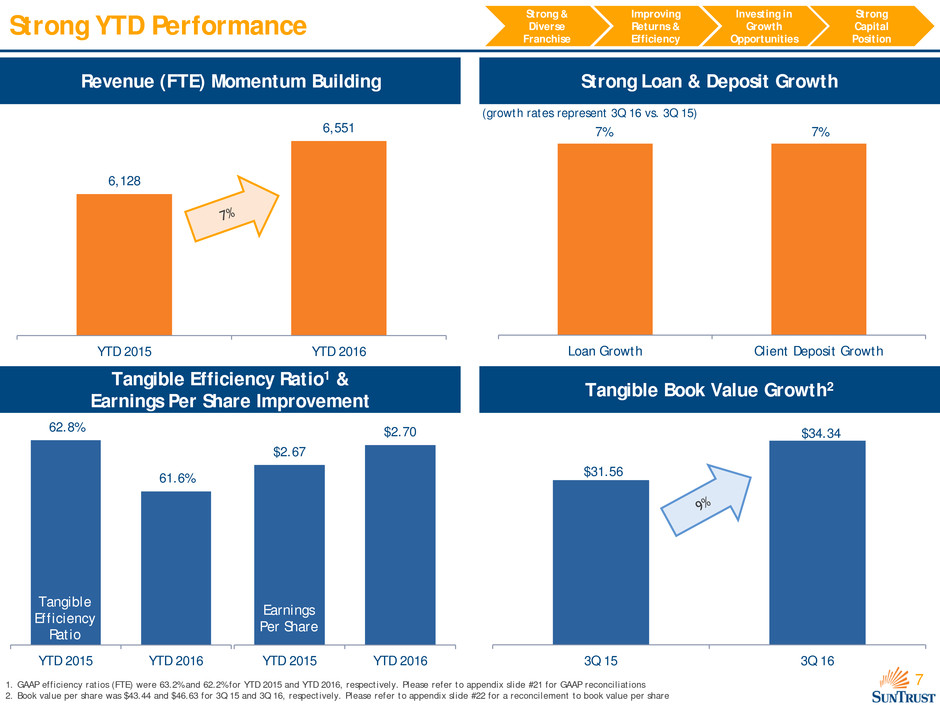
7 6,128 6,551 YTD 2015 YTD 2016 $31.56 $34.34 3Q 15 3Q 16 Strong YTD Performance Investing in Growth Opportunities Strong & Diverse Franchise Improving Returns & Efficiency Strong Capital Position 1. GAAP efficiency ratios (FTE) were 63.2% and 62.2% for YTD 2015 and YTD 2016, respectively. Please refer to appendix slide #21 for GAAP reconciliations 2. Book value per share was $43.44 and $46.63 for 3Q 15 and 3Q 16, respectively. Please refer to appendix slide #22 for a reconcilement to book value per share Revenue (FTE) Momentum Building (growth rates represent 3Q 16 vs. 3Q 15) Tangible Efficiency Ratio1 & Earnings Per Share Improvement Tangible Book Value Growth 2 Strong Loan & Deposit Growth 7% 7% Loan Growth Client Deposit Growth 62.8% 61.6% YTD 2015 YTD 2016 $2.67 $2.70 YTD 2015 YTD 2016 Tangible Efficiency Ratio Earnings Per Share

8 Strategic Consistency Key Strategies Evidence of Success 2011 Ongoing Grow and Deepen Client Relationships 2011 – LTM CAGRs 9% Investment Banking Income 18% Credit Card Balances1 5% Client Deposits1 1 Adjusted Tangible Efficiency Ratio2 Improve Efficiency 2 Optimize the Balance Sheet & Enhance Returns % Residential-Related Loans3 ROA 3 Investing in Growth Opportunities Strong & Diverse Franchise Improving Returns & Efficiency Strong Capital Position 1. Based on average balances 2. GAAP efficiency ratios (FTE) were 72.0% and 62.3% for 2011 and LTM, respectively. Please refer to appendix slide #21 for GAAP reconciliations 3. Includes guaranteed residential mortgages, non-guaranteed residential mortgages, home equity products, and residential construction loans based on period-end balances 4% Retail Investment Income 72% 62% 2011 LTM 0.38% 0.97% 2011 LTM 38% 28% 2011 3Q 16
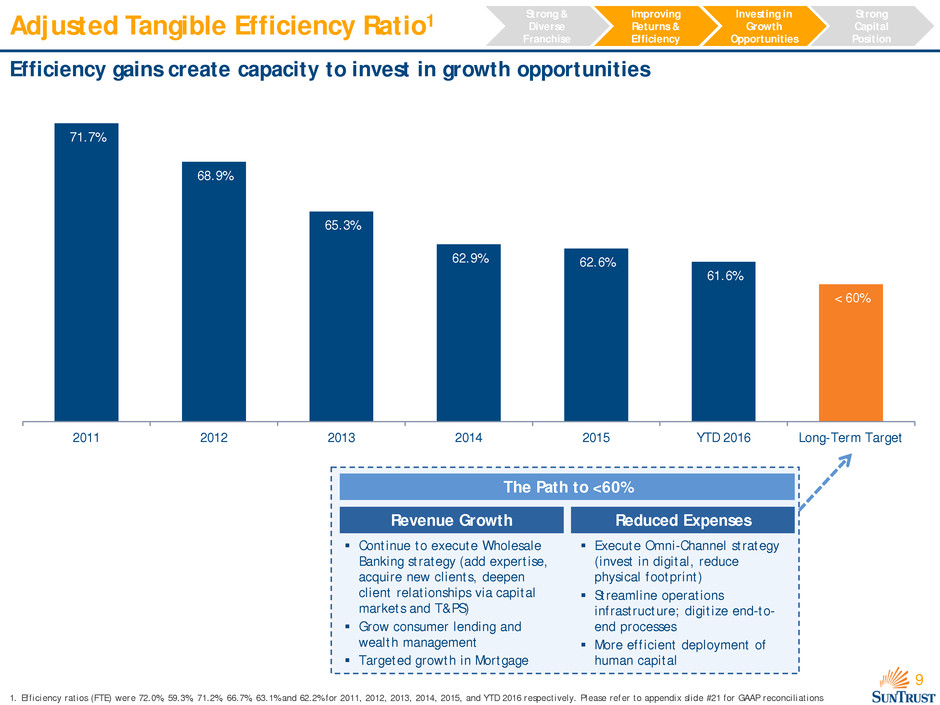
9 Adjusted Tangible Efficiency Ratio1 Efficiency gains create capacity to invest in growth opportunities Investing in Growth Opportunities Strong & Diverse Franchise Improving Returns & Efficiency Strong Capital Position 1. Efficiency ratios (FTE) were 72.0%, 59.3%, 71.2%, 66.7%, 63.1% and 62.2% for 2011, 2012, 2013, 2014, 2015, and YTD 2016 respectively. Please refer to appendix slide #21 for GAAP reconciliations Reduced Expenses Execute Omni-Channel strategy (invest in digital, reduce physical footprint) Streamline operations infrastructure; digitize end-to- end processes More efficient deployment of human capital Continue to execute Wholesale Banking strategy (add expertise, acquire new clients, deepen client relationships via capital markets and T&PS) Grow consumer lending and wealth management Targeted growth in Mortgage Revenue Growth The Path to <60% 71.7% 68.9% 65.3% 62.9% 62.6% 61.6% < 60% 2011 2012 2013 2014 2015 YTD 2016 Long-Term Target
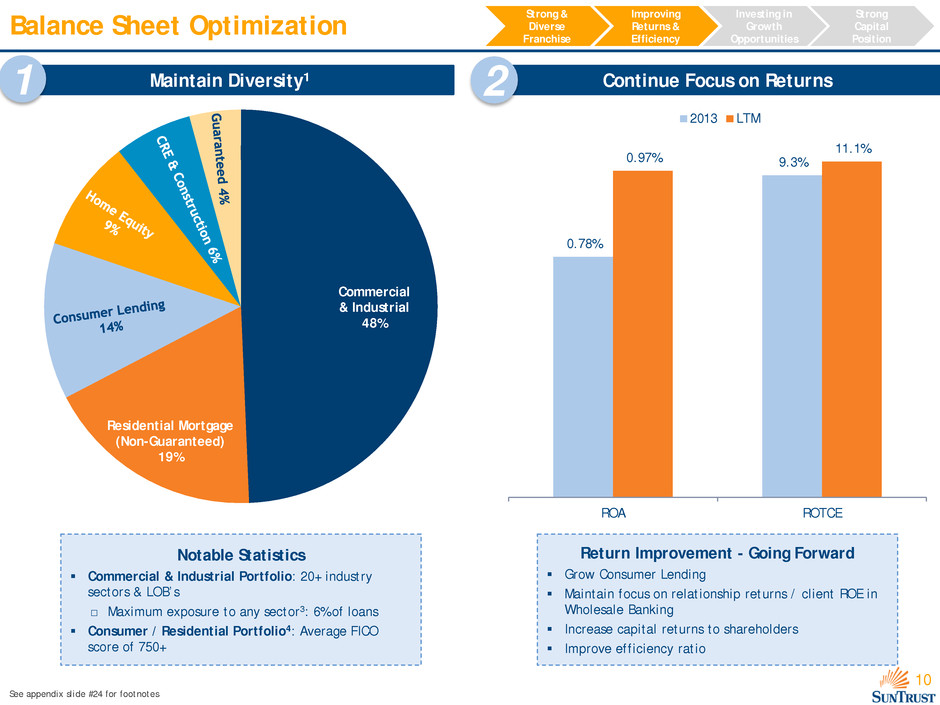
10 Balance Sheet Optimization Investing in Growth Opportunities Strong & Diverse Franchise Improving Returns & Efficiency Strong Capital Position Commercial & Industrial 49% Residential Mortgage (Non-Guaranteed) 18% Maintain Diversity1 1 Continue Focus on Returns 2 2 8 Residential Mortgage (Non-Guaranteed) 19% Notable Statistics Commercial & Industrial Portfolio: 20+ industry sectors & LOB’s □ Maximum exposure to any sector3: 6% of loans Consumer / Residential Portfolio4: Average FICO score of 750+ See appendix slide #24 for footnotes Return Improvement - Going Forward Grow Consumer Lending Maintain focus on relationship returns / client ROE in Wholesale Banking Increase capital returns to shareholders Improve efficiency ratio 0.78% 9.3% 0.97% 11.1% ROA ROTCE 2013 LTM
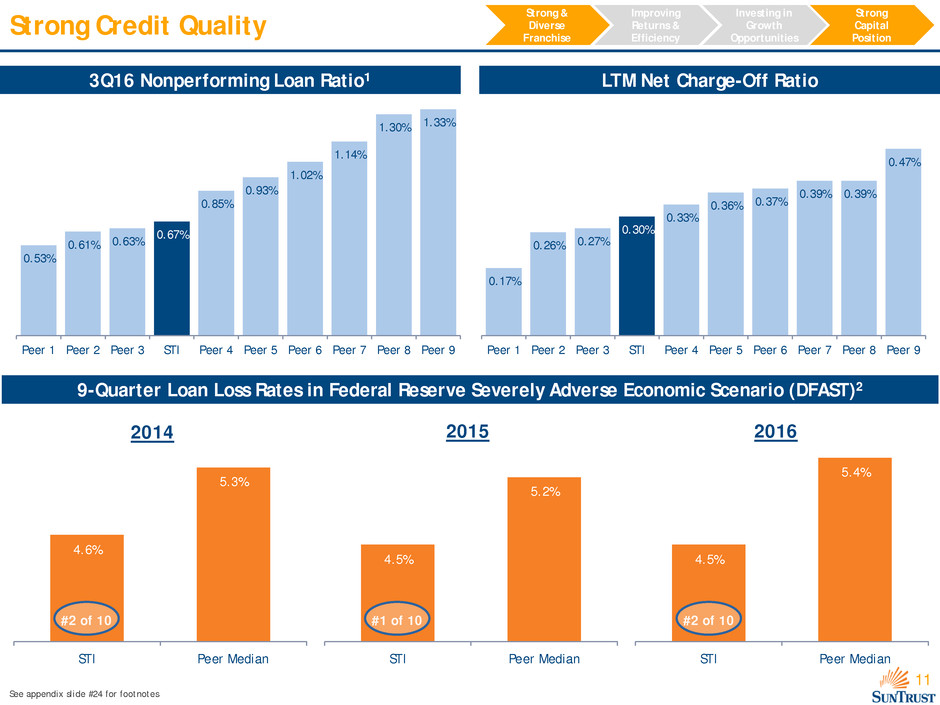
11 4.6% 5.3% STI Peer Median 4.5% 5.2% STI Peer Median 4.5% 5.4% STI Peer Median #2 of 10 Strong Credit Quality 3Q16 Nonperforming Loan Ratio1 LTM Net Charge-Off Ratio Investing in Growth Opportunities Strong & Diverse Franchise Improving Returns & Efficiency Strong Capital Position See appendix slide #24 for footnotes 9-Quarter Loan Loss Rates in Federal Reserve Severely Adverse Economic Scenario (DFAST)2 2014 2015 2016 #1 of 10 #2 of 10 0.53% 0.61% 0.63% 0.67% 0.85% 0.93% 1.02% 1.14% 1.30% 1.33% Peer 1 Peer 2 Peer 3 STI Peer 4 Peer 5 Peer 6 Peer 7 Peer 8 Peer 9 0.17% 0.26% 0.27% 0.30% 0.33% 0.36% 0.37% 0.39% 0.39% 0.47% Peer 1 Peer 2 Peer 3 STI Peer 4 Peer 5 Peer 6 Peer 7 Peer 8 Peer 9
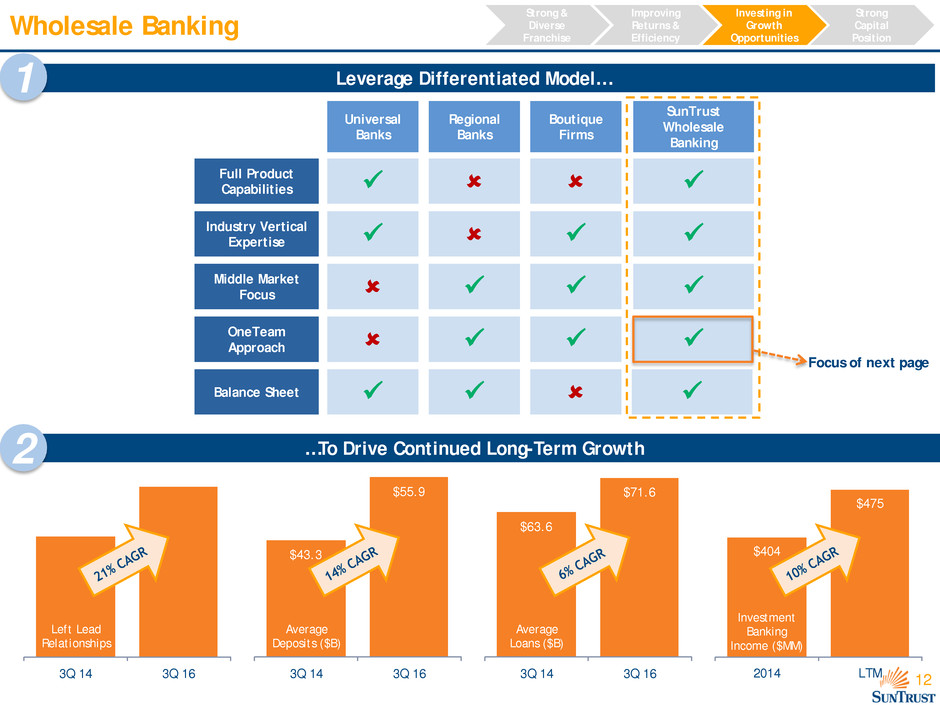
12 $43.3 $55.9 3Q 14 3Q 16 $63.6 $71.6 3Q 14 3Q 16 $404 $475 2014 LTM3Q 14 3Q 16 Wholesale Banking Investing in Growth Opportunities Strong & Diverse Franchise Improving Returns & Efficiency Strong Capital Position …To Drive Continued Long-Term Growth Left Lead Relationships Average Loans ($B) Average Deposits ($B) Investment Banking Income ($MM) 2 Leverage Differentiated Model… Full Product Capabilities Industry Vertical Expertise Middle Market Focus OneTeam Approach Balance Sheet Universal Banks Regional Banks Boutique Firms 1 SunTrust Wholesale Banking Focus of next page
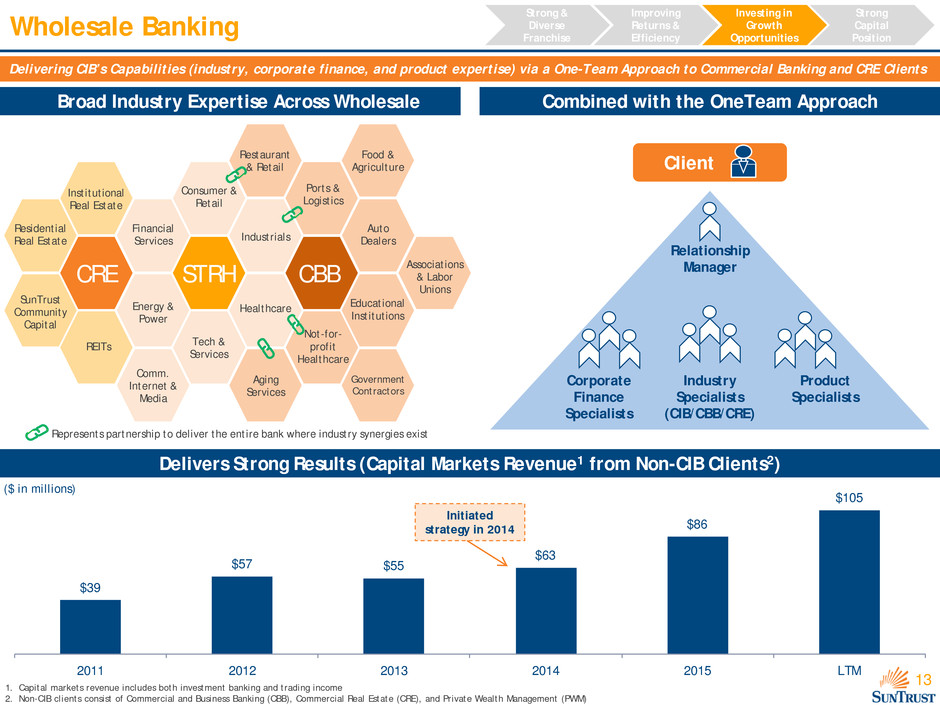
13 Wholesale Banking Broad Industry Expertise Across Wholesale Combined with the OneTeam Approach Delivers Strong Results (Capital Markets Revenue1 from Non-CIB Clients2) CRE STRH CBB Residential Real Estate Institutional Real Estate SunTrust Community Capital Financial Services Energy & Power REITs Comm. Internet & Media Consumer & Retail Industrials Healthcare Tech & Services Aging Services Restaurant & Retail Food & Agriculture Ports & Logistics Auto Dealers Associations & Labor Unions Educational Institutions Not-for- profit Healthcare Government Contractors Client Corporate Finance Specialists Industry Specialists (CIB/CBB/CRE) Relationship Manager Product Specialists $39 $57 $55 $63 $86 $105 2011 2012 2013 2014 2015 LTM Represents partnership to deliver the entire bank where industry synergies exist 1. Capital markets revenue includes both investment banking and trading income 2. Non-CIB clients consist of Commercial and Business Banking (CBB), Commercial Real Estate (CRE), and Private Wealth Management (PWM) Initiated strategy in 2014 Delivering CIB’s Capabilities (industry, corporate finance, and product expertise) via a One-Team Approach to Commercial Banking and CRE Clients Investing in Growth Opportunities Strong & Diverse Franchise Improving Returns & Efficiency Strong Capital Position ($ in millions)

14 14% 6% SunTrust Peer Median Consumer Banking More Efficient Branch Network, Creating… Investing in Growth Opportunities Strong & Diverse Franchise Improving Returns & Efficiency Strong Capital Position See Appendix slide #24 for footnotes Increasing Returns on Digital Investments 1,659 1,369 2011 3Q 16 ~ Next 2 Years Strong Market Share / Density Dense footprint (~99% of branches in an MSA, 2nd highest among peers) 50%+ of branches leased Deposit Market Share 37% 15% 41% 19% Consumer Self-service Deposits Digital Needs Met 3Q 15 3Q 16 1 2 Strong starting position enables further optimization in Branch Network #2 of 11 1

15 Consumer Banking …Further Capacity to Invest Investing in Growth Opportunities Strong & Diverse Franchise Improving Returns & Efficiency Strong Capital Position Investments in Omni Channel 2 Increased Investments to Help Grow Households & Deepen Relationships ($B) 3Q 15 3Q 16 Moving from transaction-oriented roles to more advisory roles (Universal Bankers, Premier Bankers) $40 $43 CPWM Loans $91 $96 CPWM Deposits $10 $12 Retail AUM Enhanced branch exterior with expanded ATM and Teller Connect network Improving client experience Alternate channel capabilities with expanded online and mobile banking resources
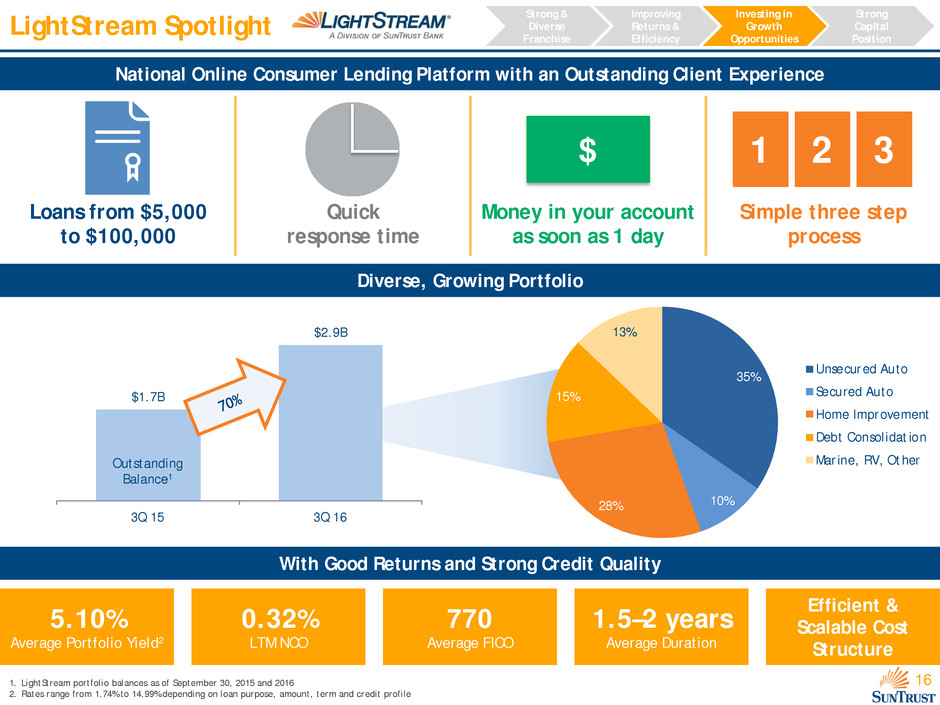
16 LightStream Spotlight Investing in Growth Opportunities Strong & Diverse Franchise Improving Returns & Efficiency Strong Capital Position 1. LightStream portfolio balances as of September 30, 2015 and 2016 2. Rates range from 1.74% to 14.99% depending on loan purpose, amount, term and credit profile With Good Returns and Strong Credit Quality 5.10% Average Portfolio Yield2 0.32% LTM NCO 770 Average FICO 1.5–2 years Average Duration Loans from $5,000 to $100,000 Quick response time $ Money in your account as soon as 1 day 1 2 3 Simple three step process National Online Consumer Lending Platform with an Outstanding Client Experience Diverse, Growing Portfolio $1.7B $2.9B 3Q 15 3Q 16 Outstanding Balance1 35% 10%28% 15% 13% Unsecured Auto Secured Auto Home Improvement Debt Consolidation Marine, RV, Other Efficient & Scalable Cost Structure

17 1.3% 1.4% YTD 15 YTD 16 2015 YTD 2016 $122 $124 3Q 15 3Q 16 Mortgage Banking Investing in Growth Opportunities Strong & Diverse Franchise Improving Returns & Efficiency Strong Capital Position ($ in billions) Loss Rate = ~3 bps 3 …With Executional Excellence Client Satisfaction Rates2 Servicing for Others UPB ($ in billions, period-end balances) Mortgage Origination Market Share1 Targeted Growth… See appendix slide #24 for footnotes $224 $0.1 Originations 1Q 09-3Q 16 Total Losses New loan origination system implemented
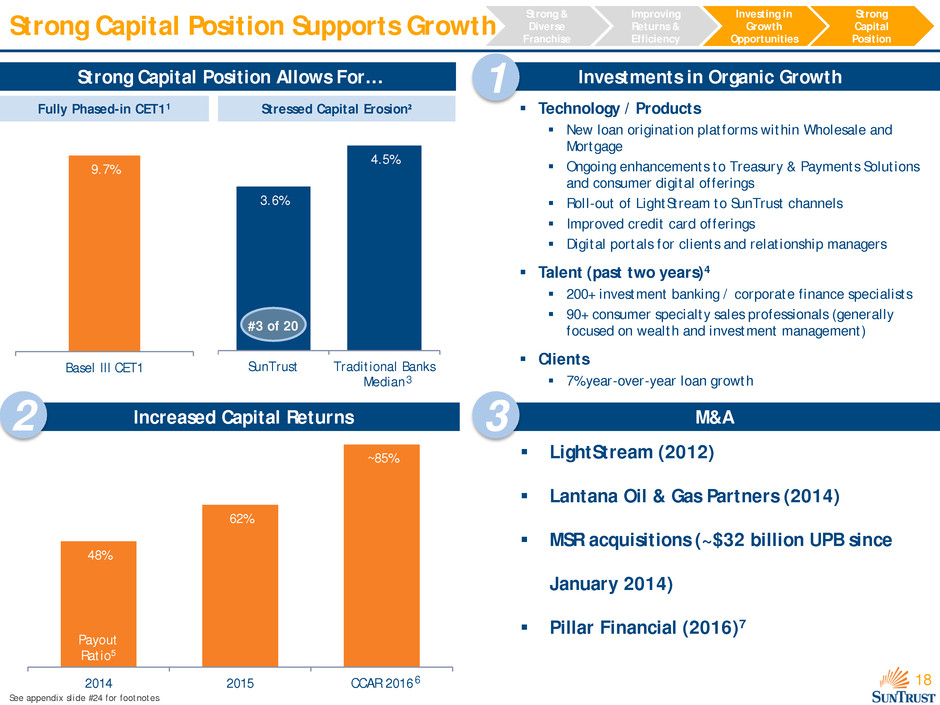
18 3.6% 4.5% SunTrust Traditional Banks Median 48% 62% ~85% 2014 2015 CCAR 2016 Strong Capital Position Supports Growth LightStream (2012) Lantana Oil & Gas Partners (2014) MSR acquisitions (~$32 billion UPB since January 2014) Pillar Financial (2016)7 Increased Capital Returns M&A Investments in Organic Growth Fully Phased-in CET11 Stressed Capital Erosion2 Strong Capital Position Allows For… Investing in Growth Opportunities Strong & Diverse Franchise Improving Returns & Efficiency Strong Capital Position 1 2 3 Payout Ratio5 See appendix slide #24 for footnotes Technology / Products New loan origination platforms within Wholesale and Mortgage Ongoing enhancements to Treasury & Payments Solutions and consumer digital offerings Roll-out of LightStream to SunTrust channels Improved credit card offerings Digital portals for clients and relationship managers Talent (past two years)4 200+ investment banking / corporate finance specialists 90+ consumer specialty sales professionals (generally focused on wealth and investment management) Clients 7% year-over-year loan growth 9.7% Basel III CET1 3 6 #3 of 20
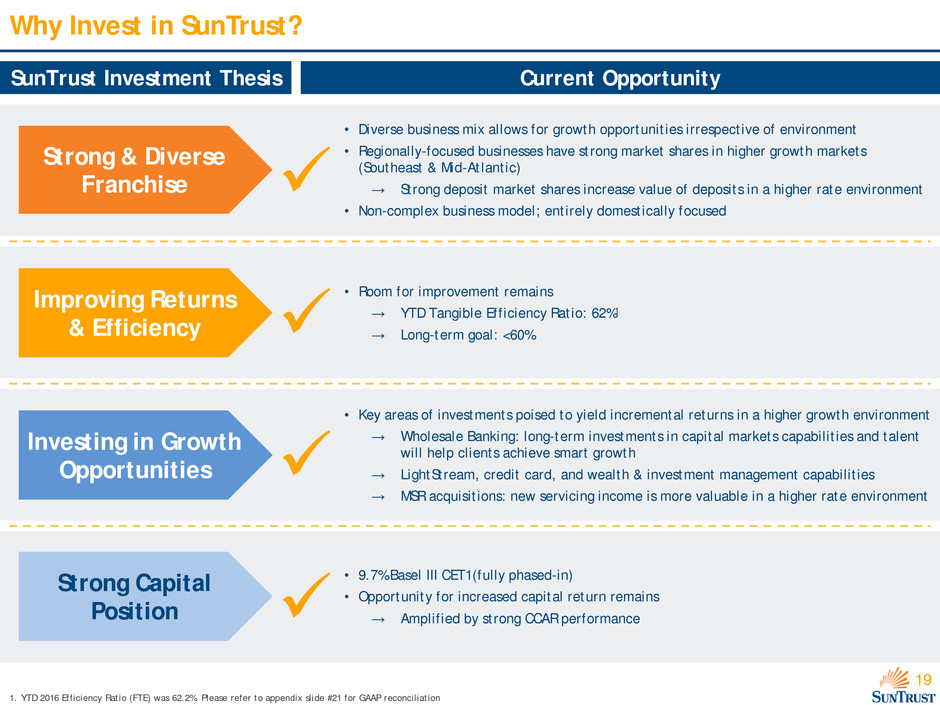
19 Why Invest in SunTrust? Current Opportunity SunTrust Investment Thesis Strong & Diverse Franchise • Diverse business mix allows for growth opportunities irrespective of environment • Regionally-focused businesses have strong market shares in higher growth markets (Southeast & Mid-Atlantic) → Strong deposit market shares increase value of deposits in a higher rate environment • Non-complex business model; entirely domestically focused • Room for improvement remains → YTD Tangible Efficiency Ratio: 62%1 → Long-term goal: <60% Improving Returns & Efficiency Investing in Growth Opportunities • Key areas of investments poised to yield incremental returns in a higher growth environment → Wholesale Banking: long-term investments in capital markets capabilities and talent will help clients achieve smart growth → LightStream, credit card, and wealth & investment management capabilities → MSR acquisitions: new servicing income is more valuable in a higher rate environment Strong Capital Position • 9.7% Basel III CET1(fully phased-in) • Opportunity for increased capital return remains → Amplified by strong CCAR performance 1. YTD 2016 Efficiency Ratio (FTE) was 62.2%. Please refer to appendix slide #21 for GAAP reconciliation

Appendix

21 Reconciliation of Adjusted Tangible Efficiency Ratio ($ in millions) 1. In accordance with updated GAAP, amortization of affordable housing investments of $40 million, $39 million, and $49 million were reclassified and are now presented in provision for income taxes for the 2011, 2012, and 2013, respectively. Previously, the amortization was presented in other noninterest expense 2. Adjusted revenue and expenses are provided as they remove certain items that are material and/or potentially non-recurring. Adjusted figures are intended to provide management and investors information on trends that are more comparable across periods and potentially more comparable across institutions 3. Represents adjusted noninterest expense / adjusted revenue – FTE. Adjusted tangible efficiency ratio excludes amortization expense, the impact of which is (0.51%), (0.53%), (0.22%), (0.31%), (0.49%), (0.49%) and (0.56%) for 2011, 2012, 2013, 2014, 2015, YTD, and LTM respectively Note: Totals may not foot due to rounding 2011 2012 2013 2014 2015 YTD 2015 YTD 2016 LTM Reported (GAAP) Basis Reported Net Interest Income - FTE $5,179 $5,225 $4,980 $4,982 $4,906 $3,625 $3,982 $5,228 Reported Noninterest Income 3,421 5,373 3,214 3,323 3,268 2,503 2,569 3,334 Reported Revenue - FTE 8,600 10,598 8,194 8,305 8,174 6,128 6,551 8,597 Reported Noninterest Expense1 6,194 6,284 5,831 5,543 5,160 3,872 4,072 5,360 Reported Amortization Expense 43 46 23 25 40 22 35 52 Reported Tangible Expense 6,151 6,238 5,808 5,518 5,120 3,850 4,037 5,308 Reported Efficiency Ratio 72.0% 59.3% 71.2% 66.7% 63.1% 63.2% 62.2% 62.3% Reported Tangible Efficiency Ratio 71.5% 58.9% 70.9% 66.4% 62.6% 62.8% 61.6% 61.7% Adjusted Basis Reported Noninterest Income $3,421 $5,373 $3,214 $3,323 $3,268 $2,503 $2,569 $3,334 Reported Revenue - FTE 8,600 10,598 8,194 8,305 8,174 6,128 6,551 8,597 Adjustment Items (Noninterest Income): 3Q-4Q 12 student / Ginnie Mae loan sale (losses) - (92) - - - - - - Securities gains/(losses) 197 1,934 (2) (15) - - - - HARP 2.0 MSR valuation adjustment (38) - - - - - - - GSE mortgage repurchase settlements - - (63) - - - - - RidgeWorth sale - - - 105 - - - - Adjusted Noninterest Income 3,262 3,531 3,279 3,233 3,268 2,503 2,569 3,334 Adjusted Revenue - FTE2 8,441 8,756 8,260 8,215 8,174 6,128 6,551 8,597 Reported Noninterest Expense 6,194 6,284 5,831 5,543 5,160 3,872 4,072 5,360 Adjustment Items: Legacy affordable housing impairment 10 96 - 28 - - - - Charitable contribution of KO shares - 38 - - - - - - Real estate charge - 17 - - - - - - Loss on debt extinguishment (3) 16 - - - - - - Pension curtailment, net of 401(k) contribution (60) - - - - - - - Severance 27 40 - - - - - - Impact of certain legacy mortgage legal matters - - 323 324 - - - - Mortgage servicing advances allowance increase - - 96 - - - - - Potential mortgage servicing settlement & claims expense 120 - - - - - - - Adjusted Noninterest Expense2 6,099 6,077 5,412 5,190 5,160 3,872 4,072 5,360 Adjusted Tangible Noninterest Expense 6,056 6,031 5,389 5,165 5,120 3,850 4,037 5,308 Adjusted Efficiency Ratio3 72.3% 69.4% 65.5% 63.2% 63.1% 63.2% 62.2% 62.3% Adjusted Tangible Efficiency Ratio3 71.7% 68.9% 65.3% 62.9% 62.6% 62.8% 61.6% 61.7%
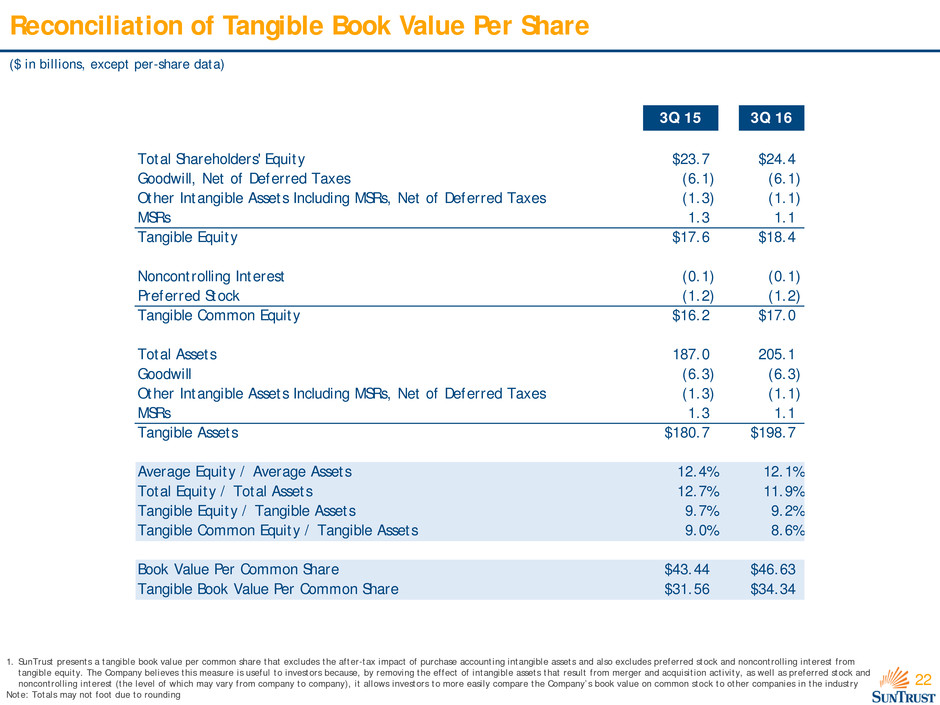
22 Reconciliation of Tangible Book Value Per Share ($ in billions, except per-share data) 1. SunTrust presents a tangible book value per common share that excludes the after-tax impact of purchase accounting intangible assets and also excludes preferred stock and noncontrolling interest from tangible equity. The Company believes this measure is useful to investors because, by removing the effect of intangible assets that result from merger and acquisition activity, as well as preferred stock and noncontrolling interest (the level of which may vary from company to company), it allows investors to more easily compare the Company’s book value on common stock to other companies in the industry Note: Totals may not foot due to rounding 3Q 15 3Q 16 Total Shareholders' Equity $23.7 $24.4 Goodwill, Net of Deferred Taxes (6.1) (6.1) Other Intangible Assets Including MSRs, Net of Deferred Taxes (1.3) (1.1) MSRs 1.3 1.1 Tangible Equity $17.6 $18.4 Noncontrolling Interest (0.1) (0.1) Preferred Stock (1.2) (1.2) Tangible Common Equity $16.2 $17.0 Total Assets 187.0 205.1 Goodwill (6.3) (6.3) Other Intangible Assets Including MSRs, Net of Deferred Taxes (1.3) (1.1) MSRs 1.3 1.1 Tangible Assets $180.7 $198.7 Average Equity / Average Assets 12.4% 12.1% Total Equity / Total Assets 12.7% 11.9% Tangible Equity / Tangible Assets 9.7% 9.2% Tangible Common Equity / Tangible Assets 9.0% 8.6% Book Value Per Common Share $43.44 $46.63 Tangible Book Value Per Common Share $31.56 $34.34

23 Reconciliation of Common Equity Tier 1 Ratio1 ($ in billions) 1. The Common Equity Tier 1 ratio is subject to certain phase-in requirements under Basel III beginning in 2015, and as such we have presented a reconciliation of the Common Equity Tier 1 ratio as calculated considering the phase-in requirements (Common Equity Tier 1 ��� Transitional) to the fully phased-in ratio 2. Primarily includes the phase-out from capital of certain DTAs, the overfunded pension asset, and other intangible assets 3. Primarily relates to the increased risk weight to be applied to mortgage servicing assets on a fully phased-in basis Note: Totals may not foot due to rounding 3Q 16 Common Equity Tier 1 - Transitional $16.9 Adjustments2 (0.1) Common Equity Tier 1 - Fully phased-in $16.8 Risk-weighted Assets: Common Equity Tier 1 - Transitional $172.5 Adjustments3 1.7 Risk-weighted Assets: Common Equity Tier 1 - Fully phased-in $174.1 Common Equity Tier 1 - Transitional 9.8% Common Equity Tier 1 - Fully phased-in 9.7%

24 Footnotes Slide #4: 1. Assets, loans, deposits, client, and teammate data as of September 30, 2016; market capitalization as of November 30, 2016 2. Rank is amongst U.S. bank holding companies and excludes non-traditional banks. Asset and loan rankings are sourced via bank holding company regulatory filings (Y-9C) and are as of September 30, 2016. Deposit rankings are sourced via FDIC deposit market share data, and are as of June 30, 2016, pro-forma for completed and pending mergers and acquisitions 3. Represents full-time equivalent employees 4. Source: SNL Financial, as of June 30, 2016, based on top 10 MSAs (by deposits) for each institution, pro-forma for completed and pending mergers and acquisitions. Numerator is company’s total deposits in its top 10 MSAs and denominator is total deposits in those 10 MSAs Note: Peer group includes BBT, CMA, COF, FITB, KEY, MTB, PNC, RF, USB, WFC Slide #14: 1. Consumer self-service deposit transactions include mobile, tablet, and ATM (excludes direct deposit) 2. Defined as all new account center units sales plus national and SunTrust.com unit sales for LightStream Slide #18: 1. Please see Appendix slide #23 to reconcile to GAAP CET1 ratio 2. Represents the difference between the starting and minimum Basel III Common Equity Tier 1 Ratios resulting from the Federal Reserve’s 2016 CCAR severely adverse scenario 3. CCAR 2016 Traditional Banks include BAC, BANCW, BBT, BBVA, BMO, C, CFG, CMA, FITB, HBAN, JPM, KEY, MTB, PNC, RF, STI, TD, USB, WFC, ZION 4. Represents net hires since January 1, 2014 5. Payout Ratio = (Common Stock Dividends and Share Repurchases) / Net Income Available to Common Shareholders 6. SunTrust’s CCAR 2016 payout ratio is based on consensus earnings estimates 7. On October 20, 2016, SunTrust Banks, Inc. announced that it had signed a definitive agreement to acquire substantially all of the assets of the operating subsidiaries of Pillar Financial, LLC. Please see http://investors.suntrust.com/news/news-details/2016/SunTrust-Bank-to-Acquire-Assets-of-Pillar-Financial-LLC/default.aspx for more information. Transaction is expected to close in late 2016 or early 2017. Slide #11: 1. Represents nonaccrual loans divided by total loans (excluding loans held for sale). Source: Company financials as of September 30, 2016 2. Source: Federal Reserve (http://www.federalreserve.gov/bankinforeg/dfa-stress-tests.htm). Represents Federal Reserve’s estimate of loan losses over 9 quarters (as a % of average total loans) in a severely adverse economic scenario Note: Peer group includes: BBT, CMA, FITB, KEY, MTB, PNC, RF, USB, WFC Slide #17: 1. Inside Mortgage Finance. 2. Data based on survey of over 800 clients conducted by Gallup. Represents overall client satisfaction with the loan origination process 3. Total losses include net charge-offs for balance sheet loans and repurchase losses for sold loans (represents all loans originated from 1Q 09 through 3Q 16) All Slides: Note: ‘LTM’ refers to the 12 months ended September 30, 2016. ‘YTD’ refers to the 9 months ended September 30, 2016. Slide #10: 1. Data as of September 30, 2016. Consumer Lending includes consumer direct loans (other than student guaranteed), consumer indirect loans and consumer credit cards. Guaranteed includes guaranteed student loans and guaranteed residential mortgages. Construction includes both commercial and residential construction. Note: totals may not foot due to rounding 2. Return on average common shareholders’ equity was 6.3%, 8.1%, and 8.0% for 2013, 2014, and LTM, respectively. The effect of excluding intangible assets, excluding MSRs, was 2.9%, 3.3%, and 2.9% for 2013, 2014, and LTM, respectively 3. Not including real estate loans which are classified as C&I 4. Represents weighted average score as of September 30, 2016. Includes consumer loans, home equity, and residential mortgage. Excludes guaranteed loans























